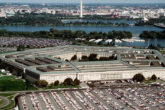March 12, 2018
For the Navy, Strike Capability Should Be Top Priority
The service risks seeing its relevance decline in A2AD environments
The United States Navy needs to make some hard choices if it wishes to remain relevant in the Anti-Access/Area Denial (A2AD) security environment that lies ahead of it. It must begin to adjust its strategy as well as its accompanying shipbuilding and aircraft-procurement plans to enable it to fight and win within the emerging great-power competition. This new environment, at last recognized in President Trump’s National Security Strategy and the Secretary of Defense’s National Defense Strategy, requires the Navy to strike enemy capitals and other vital centers of gravity from range, but the Navy’s decision to bypass a carrier-based strike asset, and now even to push off its acquisition of an unmanned mission tanker, suggest that it is not taking A2AD great-power competition seriously. Its decisions place the future relevance of the entire maritime service, at least as it is presently composed, at risk.
The modern Navy is built around the “super carrier.” Carriers, which the Navy had from the 1920s through the early 1950s, launched light fighters and attack aircraft that could carry small loads of ordnance short distances to targets. However, in World War II the Navy lost numerous ships and carriers to Japanese bombs and kamikaze attacks because the short range of U.S. Navy aircraft pulled the ships that carried them in closer to targets, which also placed the ships within range of Japanese aircraft. Navy leaders such as Vice Admirals Marc Mitscher and John S. “Slew” McCain realized that the Navy needed longer-ranged aircraft to allow commanders to keep their ships safely away from enemy shores while still enabling Navy aircraft to reach critical targets ashore.
Read the full article at the National Review.
More from CNAS
-
Lessons in Learning
Executive Summary Although claims of a revolution in military affairs may be overhyped, the potential for artificial intelligence (AI) and autonomy to change warfare is growin...
By Josh Wallin
-
The Pentagon Push to Change an “Antiquated” System
Carlton Haelig, a fellow at the Center for a New American Security, joined The Cipher Brief to discuss the systems in place in the Department of Defense and the challenges ass...
By Carlton Haelig
-
The Department of Defense’s Breakthrough Nuclear Moment Risks Slipping Away
Unless they act, the Department of Defense’s breakthrough nuclear moment may vanish before it really happens....
By Will Rogers
-
DEFAERO Strategy Series [Apr 09, 25] CNAS' Becca Wasser and Phil Sheers on Revitalizing the U.S. Defense Industrial Base
On this episode of the Defense & Aerospace Report Strategy Series, sponsored by General Atomics Aeronautical Systems, Becca Wasser and Phil Sheers of the Center for a New Amer...
By Becca Wasser & Philip Sheers




